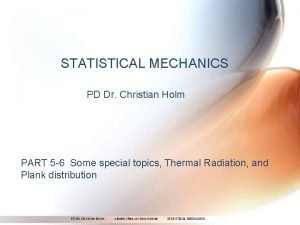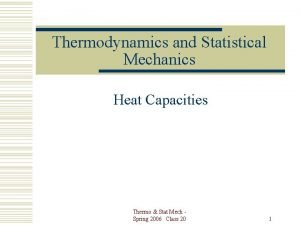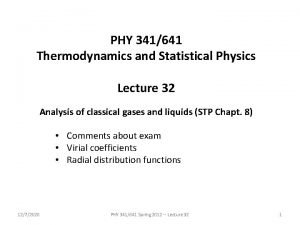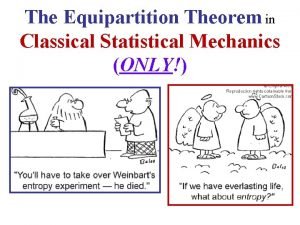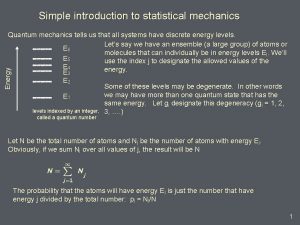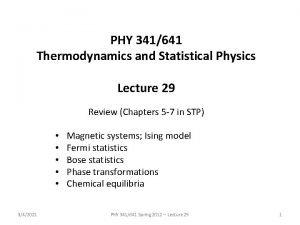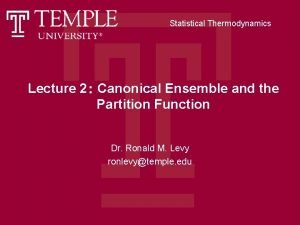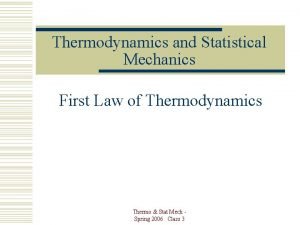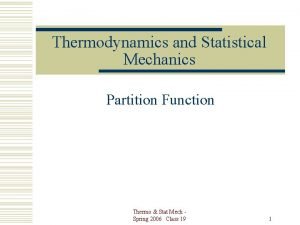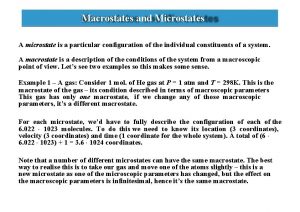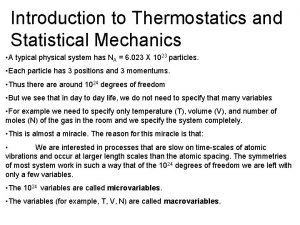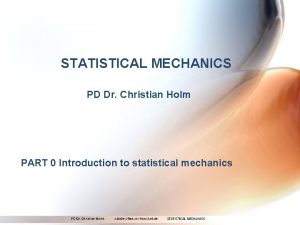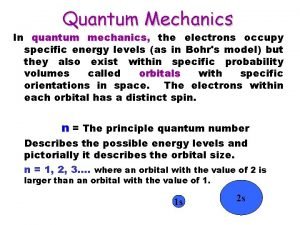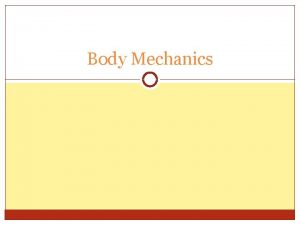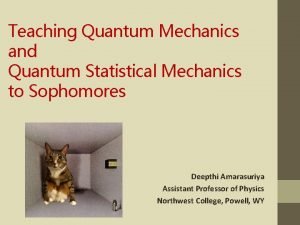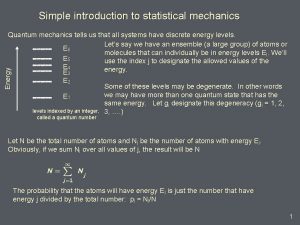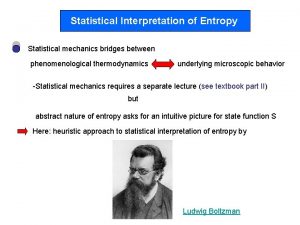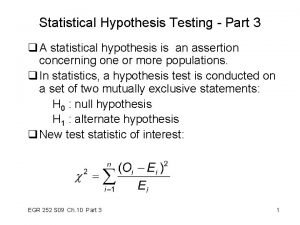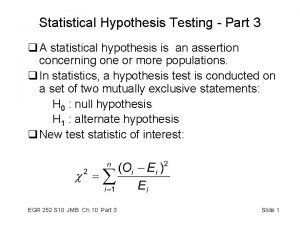STATISTICAL MECHANICS PD Dr Christian Holm PART 5


























- Slides: 26

STATISTICAL MECHANICS PD Dr. Christian Holm PART 5 -6 Some special topics, Thermal Radiation, and Plank distribution

Equipartition theorem • Let Xi be Pi or ri • Generalized equipartition theorem

Special case: • For every quadratic degree of freedom Xi in the partition function, with an energy constitution • We have

• “one half k. BT for every quadratic degree of freedom” • Therefore ideal gas: • 3 N-- quadratic degree of freedom

Additive Hamiltonian • If the Hamiltonian of a system is a sum of independent terms, the partition function is a product of independent terms, and thus the free energy is again a sum of independent terms. • We used that for the ideal gas. • Other example: Particle with translational, rotational, and vibrational degree of freedom


Partition function in generalized coordinates • The integrals will contain the Jacobian for the transformation in generalized coordinates. We are not going to look into this very much. Let’s just make one example. • Dipole in electric field

Dipole in electric field • The energy is • The rotational partition function is then given by • Explain why are different types of coordinates are useful. • Jacobian from spherical coordinates, etc. . .

(not really necessary to do the change of variable) • Substitute 4

• Via parameter differentiation, we can now work out the average component of D in the direction of the field:

Langevin function • Then we define • Then we have: • For small arguments we have , hence for small electric fields we have

THERMAL RADIATION AND PLANK DISTRIBUTION

PLANK DISTRIBUTION FUNCTION • The Plank distribution function is the first application of thermal Physics. • It describes black body radiation and also thermal energy spectrum of lattice vibrations. The energy states of quantum harmonic oscillator is given by Where integer. is the frequency of radiation and s is zero or any positive We omit the zero point energy

The partition function is then given by This sum is of the form with (A mode of radiation can only be exited in units of ).

Which is geometric series with smaller than 1, thus Which implies the partition function

Now let’s calculate (average excitation state). The probability that the system is in the state by the Boltzmann factor: The thermal average value of Chose is of energy is given

Then we have, Thus, or This is the Planck distribution function for thermal average number of photons.

Plank distribution as a function of the reduced temperature

PLANKS LAW AND STEFAN-BOLTZMANN LAW • The thermal average energy in the mode is For high temperature limit (the classical limit): Then we have the approximation And the classical average energy is

Now we want to find out the radiation modes confined with in a perfectly conducting cavity in the form of a cube of edge L , then there is a set of modes of the form (i) The field must be divergence free: (ii)

When we insert (i) into (ii) Which implies that the electromagnetic field in the cavity is transversely polarized. The modes have to satisfy the wave equation Let The frequencies have to satisfy certain conditions.

The total energy in the cavity is Replace sum by integral over

Let This is known as Stefan-Boltzmann law of radiation.

Let us write with the help of energy per unit volume per unit frequency range This result is known as Planck radiation law.

1. 6 Maximum Plot of x 3/(ex - 1) with x =ωħ/τ. This function is involved 1. 4 1. 2 in the Plank radiation law for the 1. 0 spectral density u. The temperature of 0. 8 a black body may be found from the 0. 6 frequency max at which the radiant 0. 4 energy density is a maximum, per unit frequency range. 0. 2 0 0 1 2 3 4 5 6 7 8

The entropy of thermal photons at constant volume is Then from And on integration
 Dr. christian holm
Dr. christian holm Statistical mechanics
Statistical mechanics Partition function in statistical mechanics
Partition function in statistical mechanics Thermodynamics and statistical mechanics
Thermodynamics and statistical mechanics Classical equipartition
Classical equipartition Introduction to quantum statistical mechanics
Introduction to quantum statistical mechanics Statistical mechanics
Statistical mechanics What is microcanonical ensemble
What is microcanonical ensemble Dulong petit law
Dulong petit law Stat
Stat Microstate and macrostate examples
Microstate and macrostate examples Gibbs free energy
Gibbs free energy Statistical mechanics of deep learning
Statistical mechanics of deep learning Livstræet tekst
Livstræet tekst Elisabeth holm hansen
Elisabeth holm hansen Karen holm olsen
Karen holm olsen Brit holm
Brit holm Stefan holm
Stefan holm I am david chapter 4 summary
I am david chapter 4 summary Katumus ortodoksi
Katumus ortodoksi Lennart holm
Lennart holm Birgitte hagland
Birgitte hagland Keskraamatukogu ellu
Keskraamatukogu ellu Holm center afjrotc
Holm center afjrotc Jaana holm
Jaana holm Skeemamunkki
Skeemamunkki Mikkel holm
Mikkel holm
